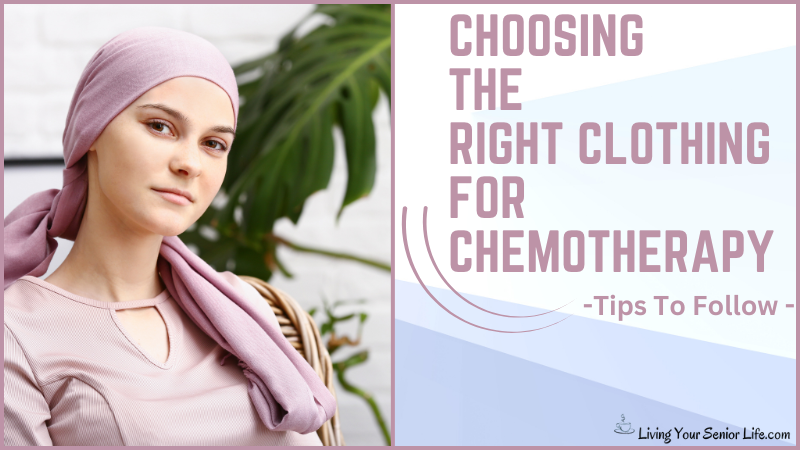Chemotherapy is a treatment that can be difficult and uncomfortable, but choosing the right clothing can make it a little easier. The purpose of this post, Choosing the Right Clothing For Chemotherapy, is to give you some tips and insight on choosing comfortable clothing that will make your chemotherapy sessions more tolerable.
Key Takeaways:
- Choosing the right clothing for chemotherapy can help reduce discomfort associated with treatment.
- Comfort and practicality should be considered when selecting clothing for chemotherapy.
- Special clothing needs, such as easy-to-wear clothes and sun protection, should also be taken into account.
Video: Choosing the Right Clothing For Chemotherapy
While undergoing treatment and choosing clothing for chemotherapy, it’s important to consider comfort, practicality, and special clothing needs. Comfortable clothing can help reduce any discomfort associated with chemotherapy, while practical clothing can make it easier to access ports or tubes. Special clothing needs may include clothing that is easy to put on and take off, clothing that covers sensitive areas, and clothing that provides warmth and protection from the sun.
The Importance of Comfort While Receiving Chemotherapy
Chemotherapy is a demanding and at times an uncomfortable experience. Chemotherapy treatments can take anywhere from 3 or 4 to 8 or more hours and even overnight. It all depends on the treatment. During chemotherapy, it is important to choose the right clothing that is comfortable, easy to wear, and allows for easy access to the treatment site. Wearing comfortable clothing during chemotherapy can help you feel more relaxed and less anxious. You may be sitting for long periods of time, so it is important to wear clothes that do not constrict your movements or cause discomfort.
You may want to choose clothing that is stylish and flattering, but it is also important to consider the practicality of the clothing. Clothing that is too tight or restrictive may not be practical for chemotherapy, and clothing that is too loose or baggy may get in the way.
It is also important to choose clothing that is easy to put on and take off. You may be feeling fatigued during your treatment and may not have the energy to struggle with complicated clothing. Clothing that is easy to put on and take off can help you conserve your energy and make the process less stressful.
Considerations for Comfort and Practicality
Here are some factors to consider when selecting clothing for your chemotherapy treatment.
Fabric Choices
The type of fabric you choose can make a big difference in how comfortable you feel during chemotherapy. Natural fibers like cotton and bamboo are soft, breathable, and gentle on the skin. Avoid irritating fabrics like wool or synthetic materials that can cause itching or irritation. Look for loose-fitting tops and pants made from soft, breathable fabrics that will help regulate your body temperature and keep you comfortable throughout your treatment.
Fit and Style
When choosing clothing for chemotherapy, it’s important to consider the fit and style of the garments. Loose-fitting tops and pants are ideal for chemotherapy patients, as they are easy to put on and take off and won’t rub against sensitive skin. Ties, buttons, and zippers can be uncomfortable, so look for tops with V-necks or button-down fronts. Elasticized waistbands are also a good option, as they provide comfort and flexibility.
Specialty Clothing
There are manufacturers that make specialty clothes geared toward chemotherapy.
These come with either zippers or velcro closures that allow the doctor or nurse quick and discreet access to a chest port or central line for chemo treatment or IV fluids or just to use a stethoscope. This will circumvent the uncomfortableness of disrobing.
Tops/Pants
Both tops and pants should be comfortable. There are a few special dressing considerations if you have either a Port-A-Cath or the Central Venous Catheter (CVC line). It’s important for you to avoid wearing clothes that might clip or puncture the line, like pins and front closure bras. They should also have easy access to ports and IVs. Shirts and tops should not be constricting. Short-sleeved shirts are recommended so the treatment technician has easy access to your arms for IVs. If you prefer long sleeves there are special tops and shirts made that either have zippers or velcro closures to be used for easy access to ports.
You want pants that are easy to take on and off. With the fluid you are taking in with treatment, it’s very likely you will have to use the restroom. Pants with an elastic waistband or yoga pants are great options.
Foot Wear
Wearing breathable shoes with rubber soles will help you stay safe on slippery floors while providing good traction. There is a wide variety of comfy socks available in the market to keep your feet warm if you take your shoes off during treatment. Some people also opt to wear slippers.
Special Clothing Needs During Chemotherapy
When going through chemotherapy, your body goes through a lot of changes that can affect your clothing needs. Here are some tips on choosing the right clothing for chemotherapy ports, hair loss, weight changes, skin sensitivity, and ostomies.
Chemo Port Access Clothing
If you have a chest port or central venous catheter, you’ll want to wear clothing that allows port access easier. Consider wearing tops with a V-neck or button-up shirts that can be easily unbuttoned. You can also wear loose-fitting tops or those with elasticized sleeves that can be pushed up. Avoid tight-fitting clothing that can irritate the port area.
Clothing for Hair Loss
Hair loss is a common side effect of chemotherapy. You may feel more comfortable wearing a hat, beanie, or scarf to cover your head. Choose soft fabrics like bamboo or natural fibers that won’t irritate your scalp. You can also wear head coverings to protect your head from the sun and keep it warm during colder weather.
Clothing for Weight Changes
Chemotherapy can cause weight gain or weight loss. You may need to adjust your clothing accordingly. If you experience weight gain, choose clothing with elasticized waistbands or loose-fitting tops and dresses. If you experience weight loss, consider wearing layered clothing or clothing with adjustable waistbands.
Clothing for Skin Sensitivity
Chemotherapy can make your skin more sensitive to fabrics and materials. Choose soft fabrics like bamboo or natural fibers that won’t irritate your skin. Avoid clothing with tags or rough seams that can cause irritation. As both chemotherapy and radiation can increase your skin’s sensitivity to sunlight use sunblock to protect your skin from the sun. Also, use a gentle moisturizer.
Clothing for Ostomies
If you have an ostomy, you may need to wear special clothing that accommodates your stoma. Look for clothing with elasticized waistbands or adjustable waistbands that won’t put pressure on your stoma. You can also wear ostomy belts or wraps to keep your ostomy pouch secure.
FAQs
Can you wear jewelry during chemo?
It is generally recommended to avoid wearing jewelry during chemotherapy treatment. Jewelry can harbor bacteria and may cause skin irritation or infection. Additionally, some chemo drugs can cause skin sensitivity, making it uncomfortable to wear jewelry. If you must wear jewelry, choose pieces that are easy to clean and avoid wearing anything that is tight or constricting.
How to wear a bra with a chemo port?
Wearing a bra with a chemo port can be uncomfortable, especially if the port is placed on the chest. It is recommended to wear a soft, wireless bra that does not have underwire. You can also wear a camisole or tank top with a built-in bra. Make sure the bra or camisole does not rub against the port area. If you experience discomfort, you can ask your healthcare provider for a numbing cream or spray to apply before your treatment.
What should I take to chemo?
It is important to pack a bag with essential items for your chemotherapy treatment. Some items to consider include comfortable clothes, such as loose-fitting pants and a soft shirt. You may also want to bring a blanket or pillow for added comfort. Entertainment items, such as books, magazines, or a tablet, can help pass the time during your treatment. Don’t forget to bring snacks and water, as well as any medications or supplements you may need. It’s a good idea to check with your healthcare provider to see if there are any specific items you should bring.
Additional Reading
Conclusion
Whether you’re undergoing cancer treatment yourself or supporting a friend or loved one, finding the right clothes can be a challenge but not impossible. The right clothing for chemotherapy can make a big difference in how you feel during your treatment. By taking into consideration the factors discussed in this article, you can ensure that you are comfortable, confident, and prepared for your chemotherapy sessions.
Remember to choose clothing that is loose-fitting, soft, and made from breathable fabrics. Consider investing in specialty clothing designed specifically for chemotherapy patients, such as port-accessible shirts or compression garments.
It’s also important to choose clothing that is easy to put on and take off, as well as clothing that allows for easy access to your treatment site. This may mean opting for clothing with button-up or zip-up fronts, or clothing that can be easily pulled on and off.
Finally, don’t forget to take into account your personal style and preferences. While comfort and functionality are important, you should still feel like yourself during your treatment. Don’t be afraid to experiment with different styles and colors to find the clothing that makes you feel your best.
By following these tips and taking the time to choose the right clothing for your chemotherapy sessions, you can help make your treatment as comfortable and stress-free as possible.
Have you found any clothing to be your go-to piece while undergoing chemotherapy? Please comment below.










